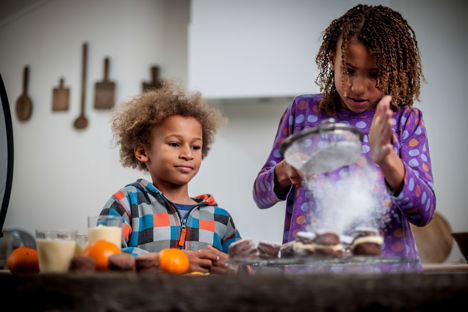
Rules and safety tips when cooking with kids
Whilst safety in the kitchen is paramount, being too cautious and overprotective can turn even the homeliest of kitchens into a fun-free zone for children. Too many rules are a turn-off for even the most curious kid; not enough rules and you run the risk of regular trips to A&E.
Rules and safety tips when cooking with kids
Whilst safety in the kitchen is paramount, being too cautious and overprotective can turn even the homeliest of kitchens into a fun-free zone for children. Too many rules are a turn-off for even the most curious kid; not enough rules and you run the risk of regular trips to A&E.
Whilst safety in the kitchen is paramount, being too cautious and overprotective can turn even the homeliest of kitchens into a fun-free zone for children. Too many rules are a turn-off for even the most curious kid; not enough rules and you run the risk of regular trips to A&E. Here are some tips that will keep both parents and kids safe, interested and happy.
• Warn: the cooker is hot! Leave that cord alone! Don’t eat cat food! You know the drill.
• Supervise: especially if they’re standing on a chair to help, and when they’re around ovens, hobs and sharp objects.
• Observe: kids are capable creatures who learn more quickly if we take a step back.
• Trust: left to their own devices, kids aren’t always naughty or clumsy.
• Answer: kids are the reason Google was invented. There’ll be many questions, and you must reply to each one.
• Praise: for washing their hands. For helping to spread the butter. For tidying up afterwards. Good for them!
Adults should:
• Give regular reminders about what’s not ok to touch. There’s the obvious: sharp objects, hot things. Then there’s your piece of cake they’ve got their eye on.
• Reiterate from an early age that cookers, kettles and hobs are hot. Keep reiterating.
• Move pots and pans to the back of the hob, with handles turned inwards.
• Be aware of dangling appliance cords that small hands can (and will) grab.
• Keep knives, scissors, matches, cooker lighters and electrical equipment such as food processors out of reach. Graters and vegetable peelers can also be very sharp.
• Avoid having small fridge magnets until kids are older.
• Teach food hygiene, mainly washing hands and rinsing vegetables. Older kids can be taught more complex safety, such as keeping raw meat separate from cooked meat.
• Lock away cleaning products, medicines and vitamins.
• Keep alcohol on a high shelf; this not only prevents children from drinking it, it acts as deterrent for harassed parents.
• Lead by example: follow food safety guidelines such as thawing food properly.
• Exercise patience: they’re new to this and will be for some time.
• Find the time: if you’re rushing you’re more likely to have accidents.
Kids should:
• Wash their hands: the sooner they learn to do this, the better.
• Wear an apron: aprons catch a lot of the mess.
• Listen to instruction: if they won’t try cooking another time.
• Tick off a recipe: they’ll learn to follow steps and gain a sense of achievement.
• Lick the bowl: it’s an integral part of growing up.
Kids can use:
• Small, safe utensils: whisks, wooden spoons and pastry brushes are a good start. As they become more au fait in the kitchen, upgrade the equipment.
• Blunt knives such as butter knives: to save fingers.
• Plastic bowls and cups: to save your best crockery.


